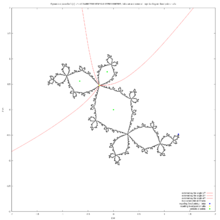Fractals/mcmullen
C programs by Curtis T McMullen[1]
How to run
[edit | edit source]julia.tar
[edit | edit source]- description[2]
Steps:
- run tcsh
- make
- copy ps2gif script to each subdirectory
- add ./ to each run script
- run
Names
[edit | edit source]- "Eye" of elephant resting on internal angle p/q of main cardioid = principal Misiurewicz point
Images
[edit | edit source]- julia.tar
-
Mandelbrot set at Fibonacci point c = -1.8705286321646448888906
-
Airplane Julia set. C is the center of period 3 component on the real axis
-
Disconnected Julia set near period 16 component ( wake 1/16)
-
disconnected ( Cantor) Julia set from wake 1/19
- kleinian.tar
-
Kleinian group limit set on sphere
-
Schottky (Kleinian) group limit set in plane
code
[edit | edit source]complex numbers
[edit | edit source]// from cx.c programs by Curtis T McMullen
// http://www.math.harvard.edu/~ctm/programs/home/prog/julia/src/julia.tar
/* Compute sqrt(z) in the half-plane perpendicular to w. */
complex contsqrt(z,w)
complex z,w;
{
complex cx_sqrt(), t;
t = cx_sqrt(z);
if (0 > (t.x*w.x + t.y*w.y))
{t.x = -t.x; t.y = -t.y;}
return(t);
}
/* Values in [-pi,pi]. */
double arg(z)
complex z;
{
return(atan2(z.y,z.x));
}
complex cx_exp(z)
complex z;
{
complex w;
double m;
m = exp(z.x);
w.x = m * cos(z.y);
w.y = m * sin(z.y);
return(w);
}
complex cx_log(z)
complex z;
{
complex w;
w.x = log(cx_abs(z));
w.y = arg(z);
return(w);
}
complex cx_sin(z)
complex z;
{
complex w;
w.x = sin(z.x) * cosh(z.y);
w.y = cos(z.x) * sinh(z.y);
return(w);
}
complex cx_cos(z)
complex z;
{
complex w;
w.x = cos(z.x) * cosh(z.y);
w.y = -sin(z.x) * sinh(z.y);
return(w);
}
complex cx_sinh(z)
complex z;
{
complex w;
w.x = sinh(z.x) * cos(z.y);
w.y = cosh(z.x) * sin(z.y);
return(w);
}
complex cx_cosh(z)
complex z;
{
complex w;
w.x = cosh(z.x) * cos(z.y);
w.y = sinh(z.x) * sin(z.y);
return(w);
}
complex power(z,t) /* Raise z to a real power t */
complex z;
double t;
{ double arg(), cx_abs(), pow();
complex polar();
return(polar(pow(cx_abs(z),t), t*arg(z)));
}
/* Map points in the unit disk onto the lower hemisphere of the
Riemann sphere by inverse stereographic projection.
Projecting, r -> s = 2r/(r^2 + 1); inverting this,
s -> r = (1 - sqrt(1-s^2))/s. */
complex disk_to_sphere(z)
complex z;
{ complex w;
double cx_abs(), r, s, sqrt();
s = cx_abs(z);
if (s == 0) return(z);
else r = (1 - sqrt(1-s*s))/s;
w.x = (r/s)*z.x;
w.y = (r/s)*z.y;
return(w);
}
complex mobius(a,b,c,d,z)
complex a,b,c,d,z;
{ return(divide(add(mult(a,z),b),
add(mult(c,z),d)));
}
escape time and potential
[edit | edit source]// from quad.c programs by Curtis T McMullen
// http://www.math.harvard.edu/~ctm/programs/home/prog/julia/src/julia.tar
/* F : \cx-K(f) -> {Re z > 0} is the multivalued
function given by lim 2^{-n} log f^n(z).
Re F(z) = rate,
(Re F(z))/|F'(z)| = dist.
Returns 1 if z escaped, 0 otherwise.
*/
escape(z,c,iterlim,rate,dist)
complex z,c;
int iterlim;
double *rate, *dist;
{
int i;
double fp, r, s;
s = 1.0;
fp = 1.0;
for(i=0; i<iterlim; i++)
{ r = cx_abs(z);
if(r > LARGE)
{ *rate = log(r)/s;
*dist = r*log (r)/fp;
return(1);
}
fp = fp * 2.0 * r;
z = add(mult(z,z),c);
s = s * 2.0;
}
return(0);
}
External ray
[edit | edit source]// from quad.c programs by Curtis T McMullen
// http://www.math.harvard.edu/~ctm/programs/home/prog/julia/src/julia.tar
/* CAUTION is 2^{1/n} */
#define LOG2 .69314718055994530941
#define SQRT2 1.414213562373095
#define LARGE 200.0
#define LENGTH 200
#define CAUTION 0.9330329915368074
#define CIRCLEPTS 1000
#define EPS 0.000001
#define RAYEPS 1e-20
#define JFAC 1.0
/* Defaults */
#define C {0, 1}
#define CENTER {0.0,0.0}
#define RADIUS 1.5
#define PCLIM 0
#define SUBDIVIDE 8
#define ITERLIM 50
/* Analytically continue Riemann mapping */
/* F : unit disk -> \cx-K(f) */
/* Assuming F(r,ang) is approx. z, find exact value*/
complex riemann(r,ang,z)
double r;
rational ang;
complex z;
{
complex orb[LENGTH], neworb[LENGTH];
int i, n;
orb[0] = z;
n = 0;
for (i=0; i<LENGTH-1; i++)
{ if(cx_abs(orb[i]) > LARGE) break;
orb[i+1] =
add(mult(orb[i],orb[i]),c);
n++;
r = 2*r;
ang.num = (2*ang.num)%ang.den;
}
neworb[n] = polar(pow(2.0,r),2*PIVAL*ang.num/ang.den);
for(i=n; i>0; i--)
{ neworb[i-1] =
contsqrt(sub(neworb[i],c),orb[i-1]);
}
return(neworb[0]);
}
/* Set the color on a line joining z to w */
scan_line(z,w,col)
complex z, w;
int col;
{
int i, n;
complex u;
n = 4*cx_abs(sub(z,w))/pixrad;
if(n == 0)
{ scan_set(z,col);
return;
}
for(i=0; i<=n; i++)
{ u.x = (i*z.x + (n-i)*w.x)/n;
u.y = (i*z.y + (n-i)*w.y)/n;
scan_set(u,col);
}
}
/* Draw an external ray */
draw_ray(level,ang)
double level;
rational ang;
{
complex lastz, z;
double r;
r = level;
while(pow(2.0,r) < LARGE) r *= 2;
z = polar(pow(2.0,r),2*PIVAL*ang.num/ang.den);
do
{ r = r*CAUTION;
lastz = z;
z = riemann(r,ang,lastz);
if(r < level*0.99)
scan_line(lastz,z,RAY);
} while(r > RAYEPS);
}
Drawing dynamic external ray using inverse Boettcher map by Curtis McMullen
[edit | edit source]
This method is based on C program by Curtis McMullen[3] and its Pascal version by Matjaz Erat[4]
There are 2 planes[5] here :
- w-plane ( or f0 plane )
- z-plane ( dynamic plane of fc plane )
Method consist of 3 big steps :
- compute some w-points of external ray of circle for angle and various radii (rasterisation)
- where
- map w-points to z-point using inverse Boettcher map
- draw z-points ( and connect them using segments ( line segment is a part of a line that is bounded by two distinct end points[6] )
First and last steps are easy, but second is not so needs more explanation.
For given external ray in plane each point of ray has :
- constant value ( external angle in turns )
- variable radius
so points of ray are parametrised by radius and can be computed using exponential form of complex numbers :
One can go along ray using linear scale :
t:1/3; /* example value */ R_Max:4; R_Min:1.1; for R:R_Max step -0.5 thru R_Min do w:R*exp(2*%pi*%i*t); /* Maxima allows non-integer values in for statement */
It gives some w points with equal distance between them.
Another method is to use nonlinera scale.
To do it we introduce floating point exponent such that :
and
To compute some w points of external ray in plane for angle use such Maxima code :
t:1/3; /* external angle in turns */ /* range for computing R ; as r tends to 0 R tends to 1 */ rMax:2; /* so Rmax=2^2=4 / rMin:0.1; /* rMin > 0 */ caution:0.93; /* positive number < 1 ; r:r*caution gives smaller r */ r:rMax; unless r<rMin do ( r:r*caution, /* new smaller r */ R:2^r, /* new smaller R */ w:R*exp(2*%pi*%i*t) /* new point w in f0 plane */ );
In this method distance between points is not equal but inversely proportional to distance to boundary of filled Julia set.
It is good because here ray has greater curvature so curve will be more smooth.
Mapping
[edit | edit source]Mapping points from -plane to -plane consist of 4 minor steps :
- forward iteration in plane
until is near infinity
- switching plane ( from to )
( because here, near infinity : )
- backward iteration in plane the same ( ) number of iterations
- last point is on our external ray
1,2 and 4 minor steps are easy. Third is not.
Backward iteration uses square root of complex number. It is 2-valued functions so backward iteration gives binary tree.
One can't choose good path in such tree without extre informations. To solve it we will use 2 things :
- equicontinuity of basin of attraction of infinity
- conjugacy between and planes
Equicontinuity of basin of attraction of infinity
[edit | edit source]Basin of attraction of infinity ( complement of filled-in Julia set) contains all points which tends to infinity under forward iteration.
Infinity is superattracting fixed point and orbits of all points have similar behaviour. In other words orbits of 2 points are assumed to stay close if they are close at the beginning.
It is equicontinuity ( compare with normality).
In plane one can use forward orbit of previous point of ray for computing backward orbit of next point.
Detailed version of algorithm
[edit | edit source]- compute first point of ray (start near infinity ang go toward Julia set )
- where
here one can easily switch planes :
It is our first z-point of ray.
- compute next z-point of ray
- compute next w-point of ray for
- compute forward iteration of 2 points : previous z-point and actual w-point. Save z-orbit and last w-point
- switch planes and use last w-point as a starting point :
- backward iteration of new toward new using forward orbit of previous z point
- is our next z point of our ray
- and so on ( next points ) until
Maxima CAS src code
/* gives a list of z-points of external ray for angle t in turns and coefficient c */ GiveRay(t,c):= block( [r], /* range for drawing R=2^r ; as r tends to 0 R tends to 1 */ rMin:1E-20, /* 1E-4; rMin > 0 ; if rMin=0 then program has infinity loop !!!!! */ rMax:2, caution:0.9330329915368074, /* r:r*caution ; it gives smaller r */ /* upper limit for iteration */ R_max:300, /* */ zz:[], /* array for z points of ray in fc plane */ /* some w-points of external ray in f0 plane */ r:rMax, while 2^r<R_max do r:2*r, /* find point w on ray near infinity (R>=R_max) in f0 plane */ R:2^r, w:rectform(ev(R*exp(2*%pi*%i*t))), z:w, /* near infinity z=w */ zz:cons(z,zz), unless r<rMin do ( /* new smaller R */ r:r*caution, R:2^r, /* */ w:rectform(ev(R*exp(2*%pi*%i*t))), /* */ last_z:z, z:Psi_n(r,t,last_z,R_max), /* z=Psi_n(w) */ zz:cons(z,zz) ), return(zz) )$
Level curve of escape time
[edit | edit source]// from quad.c programs by Curtis T McMullen
// http://www.math.harvard.edu/~ctm/programs/home/prog/julia/src/julia.tar
/* Color a level curve of escape */
draw_level(level)
double level;
{
double r;
complex lastz, w, z;
static rational zero={0,1};
rational ang;
r = level;
while(pow(2.0,r) < LARGE) r *= 2;
z = polar(pow(2.0,r),0.0);
do
{ r = r * CAUTION;
lastz = z;
z = riemann(r,zero,lastz);
} while(r > level);
lastz = z;
ang.den = CIRCLEPTS;
for(ang.num=0; ang.num<=CIRCLEPTS; ang.num++)
{ z = riemann(level,ang,lastz);
if(ang.num>0) scan_line(z,lastz,LEVEL);
lastz = z;
}
}
colors
[edit | edit source]// from quad.c programs by Curtis T McMullen
// http://www.math.harvard.edu/~ctm/programs/home/prog/julia/src/julia.tar
/* Colors */
#define FILLED_JULIA 0
#define JULIA 1
#define PC_SET 2
#define RAY 3
#define LEVEL 4
#define RESERVED 5
#define FREE (256-RESERVED)
set_gray(g)
double g;
{
int i;
scan_gray(FILLED_JULIA,g);
scan_gray(JULIA,0.0);
scan_gray(PC_SET,0.0);
scan_gray(RAY,0.0);
scan_gray(LEVEL,0.0);
for(i=0; i<FREE; i++)
scan_gray(RESERVED+i,1.0);
}
set_colors()
{
int i;
scan_hls(FILLED_JULIA,0.0,70.0,0.0);
scan_rgb(JULIA,0,0,0);
scan_rgb(PC_SET,0,255,0);
scan_rgb(RAY,0,0,0);
scan_rgb(LEVEL,0,0,0);
for(i=0; i<FREE; i++)
scan_hls(RESERVED+i,
((FREE-i)*360.0/FREE),50.0,100.0);
}
color(z)
complex z;
{
complex grad;
double rate, dist;
int i;
if(escape(z,c,iterlim,&rate,&dist))
{ if(dist < jfac*SQRT2*pixrad)
return(JULIA);
i = subdivide * log(rate)/LOG2;
while (i<0) i += FREE;
return(RESERVED + i%FREE);
}
return(FILLED_JULIA);
}
// from scan.c programs by Curtis T McMullen
// http://www.math.harvard.edu/~ctm/programs/home/prog/julia/src/julia.tar
scan_hls(i,h,l,s)
int i;
double h, l, s;
{
int r, g, b;
hlsrgb(h,l,s,&r,&g,&b);
red[i] = r; green[i] = g; blue[i] = b;
cmap = COLOR;
}
/* Convert hue/lightness/saturation to rgb */
/* Domain is [0,360] x [0,100] x [0,100]. */
/* Range is [0,255] x [0,255] x [0,255]. */
hlsrgb(h, l, s, r, g, b)
double h, l, s;
int *r, *g, *b;
{
double M, m;
double floor(), bound(), gun();
h = h - floor(h/360) * 360;
l = bound(0.0, l/100, 1.0);
s = bound(0.0, s/100, 1.0);
M = l + s*(l > 0.5 ? 1.0 - l : l);
m = 2*l - M;
*r = 255*gun(m, M, h);
*g = 255*gun(m, M, h-120);
*b = 255*gun(m, M, h-240);
}
double gun(m, M, h)
double m, M, h;
{
if(h < 0)
h += 360;
if(h < 60)
return(m + h*(M-m)/60);
if(h < 180)
return(M);
if(h < 240)
return(m + (240-h)*(M-m)/60);
return(m);
}
double bound(low, x, high)
double low, x, high;
{
if(x < low)
return(low);
if(x > high)
return(high);
return(x);
}




































